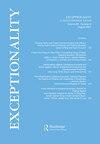Classroom Paraprofessional and Teachers Serving Students with Disruptive Behaviors: A Study of Professional Relationships
IF 0.9
4区 教育学
Q4 EDUCATION, SPECIAL
引用次数: 0
Abstract
ABSTRACTLimited research has examined the qualities of paraprofessional and teacher relationships in schools. Teachers’ and paraprofessionals’ ability to communicate and collaborate are important for guiding supports for their students. The present study examined characteristics affecting the professional relationship of paraprofessional and teacher pairs working within the same classroom across 58 elementary schools. A total of 108 pairs of paraprofessionals and teachers were asked to independently complete a multidimensional assessment of relationship quality, as well as a demographic survey. Findings overall indicate that both classroom teachers and their paraprofessionals rate their relationship qualities favorably, with paraprofessionals rating relationships more positively than teachers (ds = .28 − .34). However, there are differences in relationship ratings by race and ethnicity. Implications are discussed and suggestions are given so that paraprofessionals and teachers can continue to develop positive relationships. Disclosure statementNo potential conflict of interest was reported by the author(s).Notes1 Teacher PTRS Total; Skewness = −2.45, Kurtosis = 7.21, W = .74(p < .001). Teacher PTRS Joining; Skewness = −2.86, Kurtosis = 8.94, W = .65(p < .001). Teacher PTRS Communication; Skewness = −1.32, Kurtosis = 1.98, W = .84(p < .001). Paraprofessional PTRS total; Skewness = −1.69, Kurtosis = 3.15, W = .79(p < .001). Paraprofessional PTRS Joining; Skewness = −2.66, Kurtosis = 9.95, W = .70(p < .001). Paraprofessional PTRS Communication; Skewness = −1.61, Kurtosis = 2.00, W = .73(p < .001).Additional informationFundingThe research reported here was supported by the Institute of Education Sciences to Rutgers University (R324A170069). The opinions expressed are those of the authors and do not represent views of the IES. Correspondence concerning this article should be addressed to Joelle Fingerhut School of Social and Behavioral Sciences, Marist College, 3399 North Rd, Poughkeepsie, NY 12601. Contact: joelle.fingerhut@marist.edu课堂辅助专业人员与教师为有破坏性行为的学生服务:专业关系的研究
摘要有限的研究考察了学校中辅助专业人员和教师关系的质量。教师和辅助专业人员的沟通和协作能力对于指导学生的支持很重要。本研究调查了58所小学在同一教室工作的辅助专业人员和教师对的职业关系的影响特征。共有108对辅助专业人员和教师被要求独立完成一项关系质量的多维评估,以及一项人口调查。研究结果总体上表明,任课教师和他们的辅助专业人员对他们的关系质量的评价都是有利的,辅助专业人员对关系的评价比教师更积极(ds = 0.28−0.34)。然而,不同种族和民族对感情的评价是不同的。讨论了影响并给出了建议,以便辅助专业人员和教师能够继续发展积极的关系。披露声明作者未报告潜在的利益冲突。注1教师PTRS总分;偏度=−2.45,峰度= 7.21,W = 0.74 (p < 0.001)。教师PTRS加入;偏度=−2.86,峰度= 8.94,W = 0.65 (p < 0.001)。教师PTRS交流;偏度= - 1.32,峰度= 1.98,W = 0.84 (p < .001)。辅助专业PTRS总数;偏度= - 1.69,峰度= 3.15,W = 0.79 (p < .001)。辅助专业PTRS加盟;偏度=−2.66,峰度= 9.95,W = 0.70 (p < 0.001)。辅助专业PTRS通信;偏度= - 1.61,峰度= 2.00,W = 0.73 (p < .001)。本研究报告由罗格斯大学教育科学研究所(R324A170069)资助。所表达的观点是作者的观点,不代表IES的观点。关于这篇文章的信件应寄给Joelle Fingerhut社会和行为科学学院,Marist学院,3399 North Rd, Poughkeepsie, NY 12601。联系人:joelle.fingerhut@marist.edu
本文章由计算机程序翻译,如有差异,请以英文原文为准。
求助全文
约1分钟内获得全文
求助全文

 求助内容:
求助内容: 应助结果提醒方式:
应助结果提醒方式:


